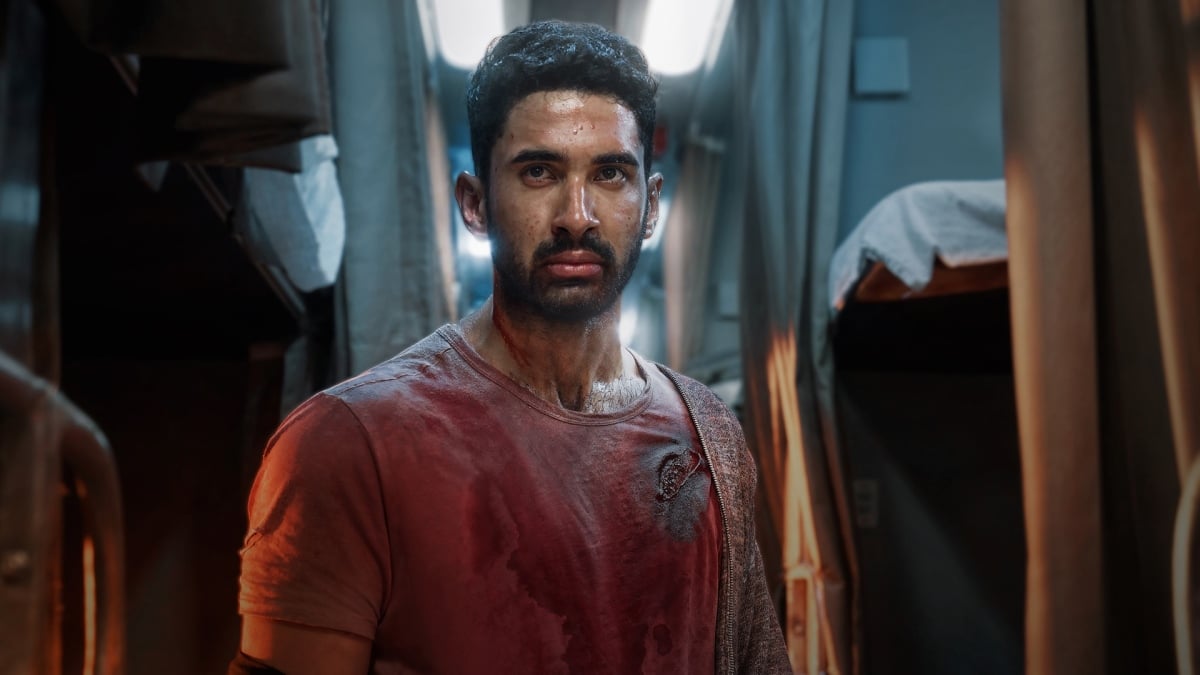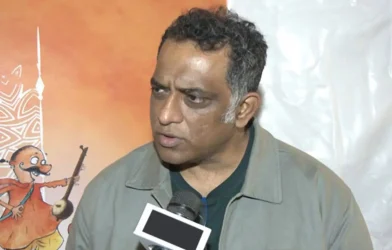Picture, if you will, the iconic hallway fight in Oldboy — which laterally tracks an outnumbered hero’s brawl with dozens of goons — spread out over an entire feature that also stops to introduce and endear you to every single villain. That’s about as close as you can get to describing Kill using well-known reference points because Nikhil Nagesh Bhat’s locomotive action thriller isn’t just viscerally effective, it’s also wildly original.
Set aboard a long-distance sleeper train, its politically charged, close-quarters mayhem has the potential to propel mainstream Hindi cinema fearlessly forward, at a time when the industry is stuck in an artistically bankrupt rut of nepotism and repetition. Produced by documentarian Oscar-winner Guneet Monga’s Sikhya Entertainment and Bollywood heavy hitter Karan Johar’s Dharma Productions — usually a purveyor of feel-good musical romance — it’s a feel-bad action explosion that revels in vengeance at its most vicious and intoxicating.
The film adores and abhors violence in equal measure. It wants to have its cake and eat it too, and it succeeds with flying colors (most of them, nauseating hues of blood red). All the while, it becomes a self-reflexive commentary on its own moving images, which range from electrifying, cheer-out-loud action scenes to horrific tableaus of grief — sometimes all at once.
What is Kill about?
Kill begins as any typical Bollywood movie might. There’s a girl, Tulika (Tanya Maniktala), whose wealthy family is set to marry her off. There’s a boy, Amrit (Lakshya), who wants to win her back. She’s pretty, witty, and resilient. He’s a handsome action hero — a commando in the Indian army who wants nothing more than to sweep her off her feet. They also both have their own respective, prototypical sidekicks, in whom they confide: a younger sister, Aahna (Adrija Sinha), and fellow army comrade Viresh (Abhishek Chauhan).
When the movie begins, it speeds through the motions of cinematic romance as if on auto-pilot, but this works in its favor. Without wasting too much time, it establishes familiar “filmi” tenets — an adjective familiar to Hindi-speaking viewers, referring to melodramatic tropes — before plunging the story into genre territory seldom explored in the Indian mainstream, and seldom approached with such keen aesthetic transformations anywhere.
As Tulika and her family travel home from her engagement celebration, Amrit, along with the trusty Viresh, boards the crowded sleeper in the hopes of stealing romantic moments with Tulika along the way, and eventually, winning over her parents once the train arrives. This premise is framed as a tongue-in-cheek army mission because for a Bollywood character like Amrit, there’s no greater victory than “getting the girl” and winning her family’s blessings. However, it isn’t long before their journey turns into an actual mission when a Die Hard-esque premise rears its head. It just so happens that this train is the target of a coordinated “dacoit” (or bandit) operation involving dozens of henchmen armed with guns and cleavers, a charge led by the smarmy Fani (Raghav Juyal), whose head honcho father coordinates the heist remotely.
A deeply sympathetic antagonist, Fani has enormous shoes to fill, and he becomes all the more desperate to prove himself when the petty train robbery goes awry, and Amrit and Viresh get physically involved to protect Tulika and her family. However, this seemingly simple setup, reminiscent of Indian action films with black-and-white morality, becomes disorientingly complex. It just so happens that the numerous goons on board are a family too. Most of them are uncles, brothers, or cousins trying to make ends meet in a society that denies them upward mobility.
Amrit’s violent reprisals may stem from a protective instinct, but in a movie that grants dramatic weight to practically every on-screen character — minor henchmen, Tulika’s industrialist father, even the others passengers — there ceases to be such a thing as clear narrative justice. And yet, it’s broken up constantly by surprising moments of dramatic respite that turn the movie’s perspective on its head before the action resumes. Blood that spurts with cartoonish flair in one scene congeals by the next, staining each surface with the imprint of stomach-churning violence that does not (and perhaps, cannot) yield salvation.
Kill is a masterclass in action evolution.

Credit: Courtesy of Roadside Attractions
The most unconventional thing about Kill isn’t just how quickly it jumps into its action scenes, but rather, how grounded and no-frills they feel, at least at first. The narrow train cars and their open compartments play host to intimate fisticuffs, but there are few overt flourishes to be found. It’s strikingly realistic in a way that most action movies never are, usually with good reason.
Each strike, stab, and open wound is purposeful from a plot standpoint, though, for anyone who might’ve heard about the movie’s indulgent violence, things might feel disconnected when these fights first begin. The editing doesn’t enhance or quicken the impact — which, mind you, is still incredibly bone-crunching — and while there’s plenty of bloodshed, the camera is mostly an unobtrusive observer, documenting the surface of action beats that are naturalistic to a fault.
Mashable Top Stories
This is a stark departure from most stylized Bollywood action, but the movie also ramps up with its own stylizations at a vital, lean-forward moment that takes things from intriguing to heart-pounding. Accompanied by one of the hardest late title drops in recent memory, a key character beat turns the movie ultra-violent, both physically and emotionally. The transformation is sudden and shocking, but is entirely rooted in the follies of mutual vengeance on both “sides” — the dacoits’ sprawling family, and the passengers Amrit and Viresh are sworn to protect — because in Kill, absolutely no one is safe.
Once all bets are off, Amrit — and the movie as a whole — become entirely unhinged, yielding a flurry of unrelenting brutality that all but turns the movie into a single, hour-long sequence of mutual escalation. If characters pause, it’s only to tend to their open wounds and briefly mourn their dead before shaking off their exhaustion and jumping back into breathless savagery shot with clarity and panache.
There’s no telling what might go down as the film’s most memorable death, but there are jaw-dropping moments involving fire hydrants, field hockey equipment, lighter fluid, and blades plunged into (and sometimes thrown at) every conceivable body part, with no dearth of impact thanks to editing that maintains every bit of momentum. It’s an absolute riot, and yet it’s broken up constantly by surprising moments of dramatic respite that turn the movie’s perspective on its head before the action quickly resumes and shakes things up again.
Newcomer Lakshya has a stunning screen presence, as a seemingly conventional Bollywood protagonist who eventually mines the depths of madness. He goes on a vengeful rampage so terrifying that Kill practically becomes a horror movie, awash in darkness and lit only by flashlight, with our hero like a slasher villain lurking in the shadows. Fani, meanwhile (who bears a passing resemblance to Amrit), starts out as a chauvinistic baddie with a casually violent streak, but Juyal’s performance peels back unexpected layers at every turn, until it’s practically impossible not to root for him in some fashion.
These notions, of ethically straightforward action that eventually yields cognitive dissonance, are also buoyed by a ferocious political undercurrent, the kind that Bollywood — an industry that has gradually leaned right in recent years — has long been afraid to confront.
Kill works because of its lucid political subtext.
Amrit and Tulika’s story is instantly recognizable as a Hindi movie hallmark, both because of what it is and what it isn’t. Its replication of the industry’s narrative status quo involves not only mirroring the kinds of characters frequently seen on-screen — star-crossed lovers separated by circumstance — but elements of their backstories often ignored.
Amrit’s last name, for instance, is Rathod, a surname typical of army characters, while Tulika’s family name is Thakur, which has its roots in a feudal title. Both names belong to Hindu “upper” castes, a subject seldom broached in Bollywood for the sake of maintaining the allure of supposedly apolitical escapism. However, in Kill, these loaded social dimensions become unavoidable the more we learn about not only Amrit and the Thakurs (for instance, the latter’s transport empire, and their friendliness with India’s police and political elite), but also Fani and his family, who come from significantly poorer backdrops, and likely “lower” and oppressed castes.
While their methods align with historical cinematic villainy, dating back to arguably the first action film, The Great Train Robbery (1903) — Kill‘s score even features hints of influence from Spaghetti Westerns — that the dacoits are acting out of financial desperation is something the film makes sure to clarify. This not only complicates the viewer’s allegiance as the film goes on, but creates a livewire tension every few scenes when some character, on either “side,” either revels in bloodthirsty murder or lets out an anguished wail over the loss of a loved one. If the film has a moral needle, it’s one that ticks relentlessly back and forth like an unpredictable metronome, challenging the audience to work through mountains of discomfort while luxuriating in some of the most raucous action Hindi cinema has ever offered.
The movie’s subtext isn’t subtle either. That its hero is an army soldier — an archetype still common in Bollywood’s deeply jingoistic sphere — turns the film into a parable for nationalistic violence, both on India’s militarized borders and well within them, given the reverence with which Amrit and several other characters speak about the Indian military. And while the film doesn’t stop to sermonize the way a more archetypical Bollywood movie might, it skillfully weaves this economic backdrop into its swiftly evolving plot.
For instance, Fani at one point refers to holding hostages for ransom as his shot at “acche din” — or “better days,” a reference to the campaign slogan of India’s current ruling party, the BJP, en route to their 2014 election. At every turn, he feels embittered by his family’s place on the lowest rungs of India’s social ladder. The film’s fury is both visceral and deeply political, and in the process, its violence becomes a contained and volatile embodiment of the contemporary Indian milieu, tearing itself apart from within in a mad scramble for survival.
And when it comes time for Kill to finally lay bare the cost of its mutual escalations, it culminates in a particularly poetic exchange amidst a climactic confrontation, one that’s both memorable when subtitled in English but particularly evocative in Hindi (this can also be glimpsed in the trailers). It concerns whether Amrit, a soldier on a righteous hero’s journey, is a “rakshak” (“protector”) or a “rakshas” (“demon”), two similar sounding words with different meanings, but only a razor-thin line between them in Indian studio cinema.
Kill walks this line with aplomb, and steps over it on either side until it blurs entirely. Few genre films are adept at both sweeping their audience up in the violent ecstasy of creative kills while also punishing them emotionally for playing along. It’s a deeply sad, deeply rousing work of action cinema that beats with incendiary passion. There’s nothing quite like it.
Kill was reviewed out of the 2024 Tribeca Film Festival.









